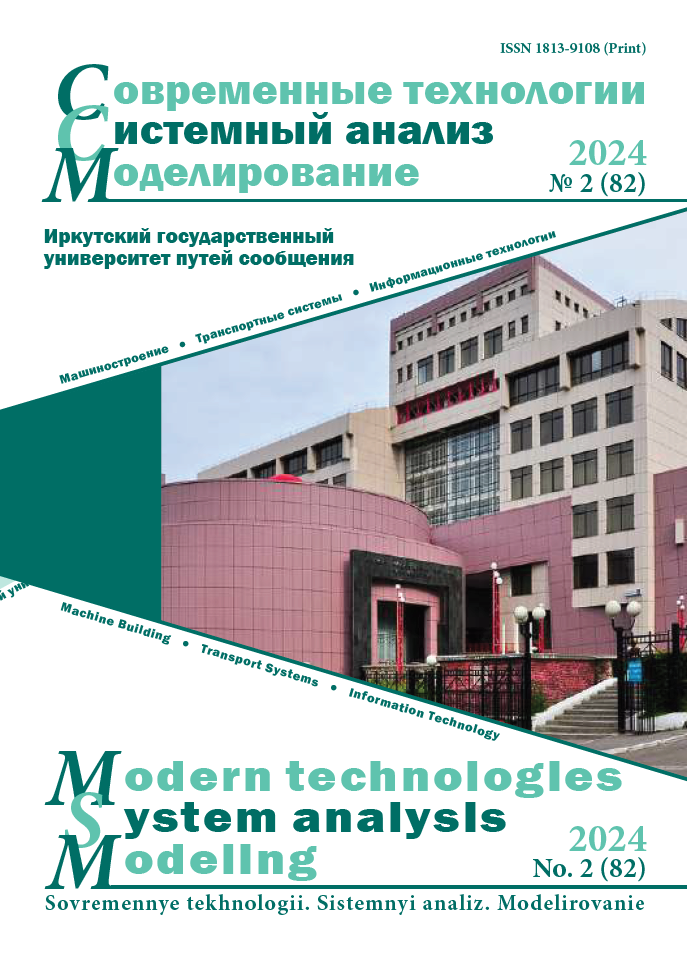Generalized forecasting of wagon turnover using a complex model that takes into account statistical and expert information
Keywords:
freight turnover, forecasting, trend models, expert assessments, wagon turnover, hierarchy analysis methodAbstract
A technology for generalized forecasting of wagon turnover using statistical and expert information taking into account the scenario approach has been proposed and tested. Wagon turnover is one of the important indicators for assessing the efficiency of the transportation process, since when it is reduced, the volume of cargo transportation increases. This indicator estimates the average time per day for using a wagon from loading to the next loading. Generalized forecasting is based on three values of wagon turnover with different weights: a) the value obtained from a three-factor model, depending on significant factors, significant factors being freight turnover, wagon productivity, sectional speed; b) the value obtained from the trend model; c) point expert judgment. The weighting coefficients were obtained by means of the hierarchy analysis method using expert judgment. Additionally, three criteria were introduced, which increased the accuracy of the weighting coefficients. As a result, expert practitioners and the authors of the article created four judgment matrices. For each matrix, the values of the consistency relations were obtained, and this made it possible to verify the consistency of the judgments of the created matrices. After processing the matrices, the final weighting coefficients for the complex criterion were obtained. The authors proposed three scenarios for the development of the transportation process for a general forecast of wagon turnover. To implement it, it was necessary to create 12 trend models. Good practical accuracy of this forecasting is shown for all three proposed scenarios, although the forecasting models themselves provide a significant error. Of the three scenarios considered, scenario 3 showed the closest value. The final forecast value is 7,01 days, and the actual value is 6,61 days. The relative error is 6,0%. This shows that even under conditions of uncertainty in the transportation process, generalized forecasting based on a complex criterion gives good practical results.
References
Фролов В.Ф., Хоменко А.П. Комплексная полигонная технология эксплуатационной работы // Железнодорожный транспорт. 2016. №2. С. 43–46.
Козлов П.А., Вакуленко С.П., Колокольников В.С. Расчет и оптимизация полигонов железнодорожного транспорта // Вестн. Ростов. гос. ун-та путей сообщ. 2017. № 3 (67). С. 96–101.
Бирюзов В.П. Об основных направлениях развития систем диагностики и мониторинга путевого хозяйства до 2025 г. // Путь и путевое хозяйство. 2015. № 4. С. 4–8.
Антипов А.Г., Марков А.А. Новые возможности магнитодинамического метода контроля рельсов // Путь и путевое хозяйство. 2016. № 8. С. 27–32.
Осьминин А.Т., Мехедов М.И., Медников Д.В. Обеспечение интероперабельности перевозок // Железнодорожный транспорт. 2019. № 7. С. 11–17.
Розенберг Е.Н., Аношкин В.В. Перспективы роста пропускной способности участков // Железнодорожный транспорт. 2020. № 3. С. 4–7.
Сотников Е.А., Мехедов М.И., Холодняк П.С. Интенсификация роста загруженных направлений сети железнодорожных дорог // Железнодорожный транспорт. 2020. № 3. С. 11–14.
Варламова С.А., Якушев М.В., Веселов Д.А. Прогнозирование количества пассажиров, перевезенных автобусами общего пользования в Пермском крае // Информационные технологии в управлении и экономике. 2020. № 2 (19). С. 50–58.
Маловецкая Е.В., Козловский А.П. Анализ моделей и принципов системного моделирования при построении прогнозных моделей погрузки грузов // International journal of open information technologies. 2020. Т. 8. № 12. С. 39–48.
Базилевский М.П. Прогнозирование грузооборота железнодорожного транспорта по регрессионным моделям с детерминированными и стохастическими объясняющими переменными // Научн. ведомости Белгород. гос. ун-та. Сер.: Экономика. Информатика. 2019. Т. 46. № 1. С. 117–129.
Давааням Т., Михайлова Е.А., Яхина А.С. Модели многофакторного оценивания основных показателей перевозки грузов // Вестн. Забайкал. гос. ун-та. 2015. № 12 (127). С. 80–86.
Сивицкий Д.А. Анализ опыта и перспектив применения искусственных нейронных сетей на железнодорожном транспорте // Вестн. Сибир. гос. ун-та путей сообщ. 2021. № 2 (57). С. 33–41.
Short-term forecasting of categorical changes in wind power with Markov chain models / M. Yoder, A.S. Hering, W.C. Navidi et al. // Wind energy. 2014. № 17. P. 1425–1439.
Краковский Ю.М.. Куклина О.Н. Бинарное прогнозирование динамических показателей на основе методов машинного обучения // Вестн. Томск. гос. ун-та. Управление, вычислительная техника и информатика. 2023. № 62. С. 50–55.
Krakovsky Y., Luzgin A. Robust interval forecasting algorithm based on a probabilistic cluster model // Journal of statistical computation and Simulation. 2018. Vol. 88, Iss. 12. P. 2309–2324.
Волкова В.Н., Черненькая Л.В., Магер В.Е. Классификация моделей в системном анализе // Науч.-техн. ведомости Санкт-Петербург. гос. политехн. ун-та. Информатика. Телекоммуникации. Управление. 2013. №3 (174). С. 33–43.
Гула Д.Н., Головчинский В.О. Прогнозирование технического состояния сложных технических комплексов на основе экспертной информации // Изв. Тульск. гос. ун-та. Технические науки. 2021. № 3. С. 260–264.
Галушкин А.И. Нейронные сети: основы теории. М. : Горячая линия-Телеком, 2010. 496 с.
Хайкин С. Нейронные сети : полный курс. М. : Вильямс, 2006. 1104 с.
Прогнозирование качества функционирования технического объекта с использованием машинного обучения / М.И. Корнилова, С.В. Бусыгин, В.Н. Ковальногов и др. // Надежность и качество сложных систем. 2023. № 4 (44). С. 152–158.
Breiman L. Random Forests // Machine Learning. 2001. Vol. 45. № 1. P. 5–32.
Краковский Ю.М., Попова Н.Н. Обобщенное прогнозирование показателя погрузки грузов при перевозке железнодорожным транспортом // Вестн. Воронеж. гос. ун-та. Сер.: Системный анализ и информационные технологии. 2020. № 3. С. 43–50.
Краковский Ю.М., Крамынина Г.Н. Исследование сценариев прогнозирования грузооборота на железной дороге с учетом экспертной информации // System Analysis & Mathematical Modeling. 2023. Т. 5. № 4. С. 417–424.
Саати Т.Л. Принятие решений : Метод анализа иерархий. М. : Радио и связь, 1993. 314 с.
Микони С.В. Теория и практика рационального выбора. М. : Маршрут, 2004. 462 с.


